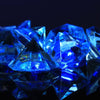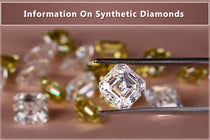Lab grown diamonds, also known as synthetic diamonds or laboratory grown diamonds, are man made gems that possess the same chemical and physical properties as natural diamonds. They are created through a controlled process in a laboratory environment. In this blog, we will survey what lab grown diamonds are and how they are made.
What are Lab Grown Diamonds?
Lab grown diamonds are diamonds that are produced in a laboratory instead of being formed naturally in the Earth's crust. They have the same crystal structure, chemical composition, and optical properties as natural diamonds. The main difference lies in their origin natural diamonds are created deep within the Earth over millions of years, while lab grown diamonds are grown in a matter of weeks or months using advanced technology.
How are Lab Created Diamonds Made?
There are two primary methods used to create lab created diamonds: High Pressure, High Temperature (HPHT), and Chemical Vapor Deposition (CVD).
High Pressure, High Temperature (HPHT) Method
In the HPHT method, a small diamond seed, typically a natural diamond fragment or a lab grown diamond, is placed in a chamber. The chamber is then subjected to intense heat and pressure that mimic the conditions deep within the Earth where natural diamonds form. A carbon source, such as graphite, is also present in the chamber. Under these conditions, the carbon atoms dissolve in the molten metal and crystallize around the diamond seed, causing it to grow layer by layer. This process is carefully controlled to ensure the growth of a high quality diamond.
Chemical Vapor Deposition (CVD) Method
The CVD method involves placing a diamond seed in a sealed chamber filled with hydrocarbon gases, such as methane. The chamber is then heated to create a plasma environment. The hydrocarbon gases break down into carbon atoms, which are then deposited onto the diamond seed, causing it to grow. The carbon atoms layer upon the seed over time, forming a larger diamond. This process allows for precise control of the diamond's growth and enables the creation of high quality diamonds.
Advantages of Lab Created Diamonds
Lab created diamonds offer several advantages over natural diamonds:
Cost: Lab created diamonds are generally more affordable than natural diamonds of comparable quality. The controlled production process reduces the costs associated with mining and sourcing natural diamonds.
- Ethical Considerations: Lab grown diamonds are conflict free, as they are produced in a controlled environment and do not contribute to unethical mining practices. They offer a socially responsible alternative for those concerned about the origin of their diamonds.
- Environmental Impact: Diamond mining can have a significant environmental impact, including habitat disruption and pollution. lab grown diamonds have a smaller ecological footprint, making them a more sustainable choice.
Lab grown Diamonds vs. Natural Diamonds: Understanding the Differences
Lab created diamonds have long been adulated for their beauty and rarity. Lab-grown diamonds instead of natural diamonds have given the diamond industry a new and modern impetus for discussion. In this article, we will compare lab grown diamonds and natural diamonds, discuss the concept of the best lab created diamonds, and delve into the world of laboratory grown diamonds.
Natural Diamonds
Origin:
Natural diamonds are formed deep within the Earth's mantle over billions of years under extreme heat and pressure. On the other hand, lab grown diamonds are created in controlled laboratory environments using advanced technology.
Composition and Structure
Both lab grown and natural diamonds have the same chemical composition pure carbon and possess the characteristic crystal structure of diamonds. From a chemical and physical standpoint, lab grown diamonds are virtually identical to natural diamonds.
Availability and Supply
Natural diamonds are finite resources that are mined from the Earth. Their availability and supply are dependent on geological factors and the mining industry. In contrast, lab grown diamonds can be produced in larger quantities and provide a more consistent supply since they are created in laboratories.
Quality and Grading:
Lab grown diamonds undergo the same quality assessments and grading processes as natural diamonds. Gemological laboratories, such as the Gemological Institute of America (GIA), evaluate lab grown diamonds using the same criteria known as the "Four Cs": carat weight, color, clarity and cut as they do for natural diamonds.
0.81 CT Round Diamond Ring, EF/VS Lab Grown Diamond Engagement Ring
Best Lab Created Diamonds
When comes to the best choice of the lab-created diamond, several elements come as the first primacy.
- Quality: The lab grown diamonds quality is the first and high element. A lab-created diamond quality has determined with their color, clarity, cut. The closer a lab grown diamond's attributes align with those of a high quality natural diamond, the more desirable it is considered.
- Certification: Reputable lab grown diamond manufacturers provide grading reports from independent Gemological laboratories, such as the GIA or the International Gemological Institute (IGI). These reports certify the quality and authenticity of the lab grown diamond.
- Personal Preferences: Beauty is subjective, and individual preferences for color, size, and shape play a significant role in determining the best lab created diamond for a person. What may be ideal for one individual might not be the same for another.
Laboratory Grown Diamonds
The term "laboratory grown diamonds" encompasses diamonds created using various methods, such as High-Pressure, High Temperature (HPHT), and Chemical Vapor Deposition (CVD). Both methods stimulate the natural diamond-growing process but with controlled conditions in a laboratory setting.
High-Pressure, High-Temperature (HPHT) Method
In the HPHT method, a diamond seed is subjected to high pressure and high temperature, allowing carbon to dissolve and crystallize around the seed, resulting in a larger diamond.
Chemical Vapor Deposition (CVD) Method
The CVD method involves the deposition of carbon atoms onto a diamond seed in a plasma environment created by hydrocarbon gases. Over time, the carbon atoms accumulate, leading to the growth of a diamond.
Lab grown diamonds possess several notable features that make them distinct and appealing. Here are some features of lab-grown diamonds:
-
Chemical and Physical Properties: Lab-grown diamonds have the same chemical framework as natural diamonds, consisting of pure carbon systematized in a crystal lattice structure. They define identical physical properties, including hardness, refractive index, and thermal conductivity. This ensures that lab grown diamonds possess the same brilliance, fire, and durability as natural diamonds.
-
Clarity and Color Options: Lab grown diamonds offer a wide range of clarity and color options. They can be found in various grades of clarity, from flawless to included, and in a spectrum of colors, including colorless, near-colorless, and fancy colored diamonds. This allows consumers to choose lab grown diamonds that align with their desired appearance and budget.
-
Sustainability: One of the notable features of lab grown diamonds is their sustainability. They are created in a controlled laboratory environment using sustainable practices, which significantly reduces the environmental impact compared to diamond mining. Choosing lab grown diamonds promotes responsible sourcing and supports a more eco-friendly approach to jewelry.
-
Ethical Sourcing: Lab grown diamonds are an ethical choice as they are not associated with the ethical concerns sometimes linked to the natural diamond industry, such as human rights abuses or conflict mining. They offer consumers the assurance that their diamonds are produced without contributing to these issues.
-
Availability and Consistency: Lab grown diamonds offer a consistent supply and availability. Unlike natural diamonds, which are limited by geological factors, lab grown diamonds can be produced in larger quantities and sizes. This ensures that consumers have a broader selection to choose from and reduces the rarity factor often associated with natural diamonds.
-
Competitive Pricing: Lab grown diamonds are typically priced lower than natural diamonds of comparable quality. The controlled production process and increased availability contribute to their affordability. This allows consumers to obtain larger or higher-quality diamonds within their budget.
- Certification and Traceability: Lab grown diamonds are subjected to the same rigorous grading and certification processes as natural diamonds. GIA and IGI, independent Gemological laboratories, assess and certify lab grown diamonds to ensure they are of high quality and authentic.
IGI Certified Emerald Cut Lab Grown Diamond Solitaire Engagement Ring
-
Design Versatility: Lab grown diamonds can be created in various shapes and sizes, offering designers and jewelers greater flexibility in creating unique and custom jewelry pieces. Whether it's a classic round brilliant cut, a trendy cushion cut, or an intricate fancy shape, lab grown diamonds can be tailored to fit any design aesthetic.
-
Consistent Quality: Lab created diamonds exhibit consistent and predictable quality. The controlled growth process ensures uniformity in terms of color, clarity, and other characteristics. This allows consumers to make informed decisions and have a clear understanding of what to expect when purchasing a lab grown diamond.
-
Reduced Environmental Disruption: Traditional diamond mining can cause significant environmental disruption, including deforestation, soil erosion, and habitat destruction. lab grown diamonds contribute to reducing these adverse impacts by eliminating the need for mining operations, and helping preserve natural ecosystems.
-
Confidence in Origin: Lab grown diamonds provide full transparency regarding their origin. Consumers can trace the journey of a lab grown diamond from the laboratory to the jewelry piece, ensuring the diamond's authenticity and ethical sourcing.
- Growing Popularity: Lab grown diamonds are gaining popularity and acceptance in the market. As more consumers become aware of their benefits, the demand for lab grown diamonds continues to rise. This increased demand drives innovation and further investment in technology, leading to improvements in the quality and variety of lab grown diamonds available.
- Positive Social Impact: The growth of the lab grown diamond industry contributes to job creation and economic development in regions where laboratories are located. This positive social impact strengthens the argument for supporting the lab created diamond sector as a means of sustainable economic growth.
Conclusion
In conclusion, when considering lab grown diamonds versus natural diamonds, it is important to evaluate the factors that matter most to you as a consumer. Diamondrensu, a reputable lab grown diamond company, offers a range of high-quality lab-created diamonds that exhibit the same beauty and characteristics as natural diamonds.
Lab grown diamonds, including those from Diamondrensu, provide a sustainable and ethical alternative to mined diamonds. They are created through developed processes such as High-Pressure, High-Temperature (HPHT), and Chemical Vapor Deposition (CVD) in moderated laboratory environments.
Diamondrensu's lab grown diamonds undergo rigorous grading and certification by renowned Gemological laboratories, ensuring their quality and authenticity. Whether you prioritize color, clarity, or cut, Diamondrensu offers a selection of lab-created diamonds to suit individual preferences.
By choosing lab grown diamonds from Diamondrensu, you can enjoy the beauty and brilliance of diamonds while making a socially responsible and environmentally conscious choice. With their commitment to providing top-quality lab grown diamonds, Diamondrensu remains a trusted name in the world of laboratory grown diamonds.













